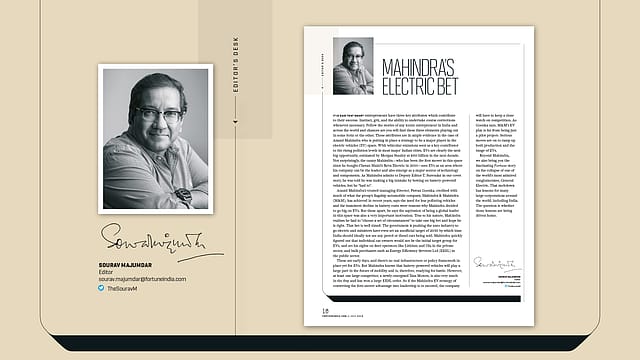Mahindra’s electric bet
ADVERTISEMENT

It is said that smart entrepreneurs have three key attributes which contribute to their success: Instinct, grit, and the ability to undertake course corrections whenever necessary. Follow the stories of any iconic entrepreneur in India and across the world and chances are you will find these three elements playing out in some form or the other. These attributes are in ample evidence in the case of Anand Mahindra who is putting in place a strategy to be a major player in the electric vehicles (EV) space. With vehicular emissions seen as a key contributor to the rising pollution levels in most major Indian cities, EVs are clearly the next big opportunity, estimated by Morgan Stanley at $60 billion in the next decade. Not surprisingly, the canny Mahindra—who has been the first mover in this space since he bought Chetan Maini’s Reva Electric in 2010—sees EVs as an area where his company can be the leader and also emerge as a major source of technology and components. As Mahindra admits to Deputy Editor T. Surendar in our cover story, he was told he was making a big mistake by betting on battery-powered vehicles, but he “had to” .
Anand Mahindra’s trusted managing director, Pawan Goenka, credited with much of what the group’s flagship automobile company, Mahindra & Mahindra (M&M), has achieved in recent years, says the need for less polluting vehicles and the imminent decline in battery costs were reasons why Mahindra decided to go big on EVs. But these apart, he says the aspiration of being a global leader in this space was also a very important motivation. True to his nature, Mahindra realises he had to “choose a set of circumstances” to take one big bet and hope he is right. That bet is well timed. The government is pushing the auto industry to go electric and ministers have even set an unofficial target of 2030 by which time India should ideally not see any petrol or diesel cars being sold. Mahindra quickly figured out that individual car owners would not be the initial target group for EVs, and set his sights on fleet operators like Lithium and Ola in the private sector, and bulk purchasers such as Energy Efficiency Services Ltd (EESL) in the public sector .
These are early days, and there’s no real infrastructure or policy framework in place yet for EVs. But Mahindra knows that battery-powered vehicles will play a large part in the future of mobility and is, therefore, readying for battle. However, at least one large competitor, a newly-energised Tata Motors, is also very much in the fray and has won a large EESL order. So if the Mahindra EV strategy of converting the first-mover advantage into leadership is to succeed, the company will have to keep a close watch on competition. As Goenka says, M&M’s EV play is far from being just a pilot project: Serious moves are on to ramp up both production and the range of EVs.
January 2026
Netflix, which has been in India for a decade, has successfully struck a balance between high-class premium content and pricing that attracts a range of customers. Find out how the U.S. streaming giant evolved in India, plus an exclusive interview with CEO Ted Sarandos. Also read about the Best Investments for 2026, and how rising growth and easing inflation will come in handy for finance minister Nirmala Sitharaman as she prepares Budget 2026.
Beyond Mahindra, we also bring you the fascinating Fortune story on the collapse of one of the world’s most admired conglomerates, General Electric. That meltdown has lessons for many large corporations around the world, including India. The question is whether those lessons are being driven home.
The Fortune India July 2018 issue is on stands. Subscribe here
